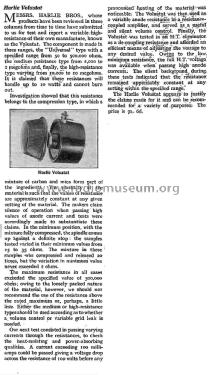Harlie Volustat
Harlie Bros.Ltd., London
- Country
- Great Britain (UK)
- Manufacturer / Brand
- Harlie Bros.Ltd., London
- Year
- 1929 ?
- Category
- Radio part (not a module)
- Radiomuseum.org ID
- 332126
- Power type and voltage
- No Power needed
- Material
- Various materials
- from Radiomuseum.org
- Model: Harlie Volustat - Harlie Bros.Ltd., London
- Shape
- Miscellaneous shapes - described under notes.
- Notes
-
Volustat
The component is made in three ranges, the "Universal" type with a specified range from 50 to 500,000 ohms, the medium resistance type from 2,000 to 2 megohms and, finally, the high-resistance type varying from 10,000 to 10 megohms. It is claimed that these resistances will handle up to 10 watts and cannot burnout.
Investigation showed that this resistance belongs to the compression type, in which a mixture of carbon and mica form part of the ingredients. The elasticity of the material is such that the values of resistance are approximately constant at any given setting of the material. The makers claim silence of operation when passing high values of anode current and tests were accordingly made to substantiate these claims. In the minimum position, with the mixture fully compressed, the spindle comes up against a definite stop. The samples tested varied in their minimum values from 25 to 35 ohms. The mixture in these samples was compressed and released 20 times, but the variation in minimum value never exceeded 2 ohms. The maximum resistance in all cases exceeded the specified value of 500,000 ohms; owing to the loosely packed nature of the material, however, we should not recommend the use of the resistance above the rated maximum or, perhaps, a little less. Either the medium or high resistance types should be used according as to whether a volume control or variable grid leak is needed.
Our next test consisted in passing varying currents through the resistances, to check the heat-resisting and power absorbing qualities. A current exceeding 100 milliamps could be passed giving a voltage drop across the resistance of 100 volts before any pronounced heating of the material was noticeable. The Volustat was then used as a variable anode resistance in a resistance coupled amplifier and served as a useful and silent volume control. Finally, the Volustat was tested in an HT Eliminator as a de-coupling resistance and afforded an efficient means of adjusting the voltage to any desired value. Owing to the low minimum resistance, the full HT voltage was available when passing high anode currents. The silent background during these tests indicated that the resistance remained appreciably constant at any setting within the specified range.
The Harlie Volustat appears to justify the claims made for it and can be recommended for a variety of purposes: The price is 7s. 6d.
Amateur Wireless Aug 31, 1929, Page 236
- Price in first year of sale
- 0.38 £
- Mentioned in
- -- Original prospect or advert (Amateur Wireless Aug 31, 1929, Page 236)
- Author
- Model page created by Gary Cowans. See "Data change" for further contributors.
- Other Models
-
Here you find 8 models, 6 with images and 0 with schematics for wireless sets etc. In French: TSF for Télégraphie sans fil.
All listed radios etc. from Harlie Bros.Ltd., London
